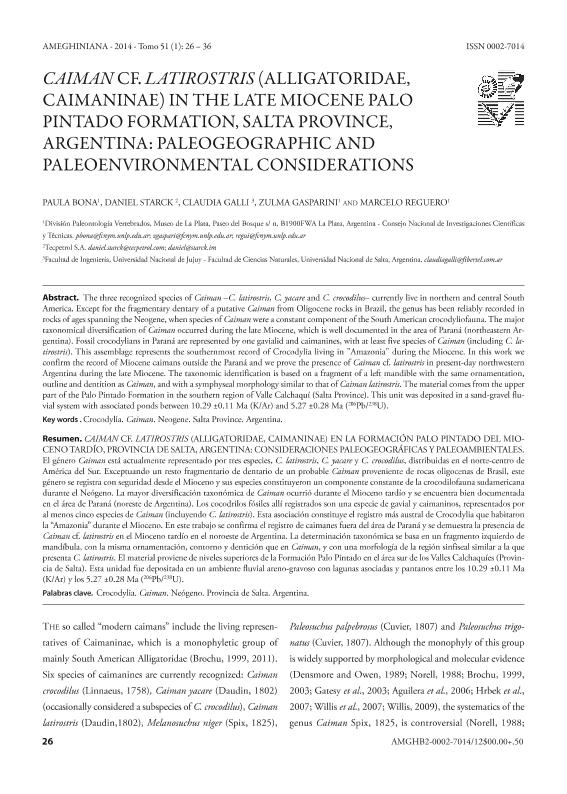Artículo
The three recognized species of Caiman –C. latirostris, C. yacare and C. crocodilus– currently live in northern and central South America. Except for the fragmentary dentary of a putative Caiman from Oligocene rocks in Brazil, the genus has been reliably recorded in rocks of ages spanning the Neogene, when species of Caiman were a constant component of the South American crocodyliofauna. The major taxonomical diversification of Caiman occurred during the late Miocene, which is well documented in the area of Paraná (northeastern Argentina). Fossil crocodylians in Paraná are represented by one gavialid and caimanines, with at least five species of Caiman (including C. latirostris). This assemblage represents the southernmost record of Crocodylia living in "Amazonia" during the Miocene. In this work we confirm the record of Miocene caimans outside the Paraná and we prove the presence of Caiman cf. latirostris in present-day northwestern Argentina during the late Miocene. The taxonomic identification is based on a fragment of a left mandible with the same ornamentation, outline and dentition as Caiman, and with a symphyseal morphology similar to that of Caiman latirostris. The material comes from the upper part of the Palo Pintado Formation in the southern region of Valle Calchaquí (Salta Province). This unit was deposited in a sand-gravel fluvial system with associated ponds between 10.29 ±0.11 Ma (K/Ar) and 5.27 ±0.28 Ma (206Pb/238U). CAIMAN CF. LATIROSTRIS (ALLIGATORIDAE, CAIMANINAE) EN LA FORMACIÓN PALO PINTADO DEL MIOCENO TARDÍO, PROVINCIA DE SALTA, ARGENTINA: CONSIDERACIONES PALEOGEOGRÁFICAS Y PALEOAMBIENTALES. El género Caiman está actualmente representado por tres especies, C. latirostris, C. yacare y C. crocodilus, distribuidas en el norte-centro de América del Sur. Exceptuando un resto fragmentario de dentario de un probable Caiman proveniente de rocas oligocenas de Brasil, este género se registra con seguridad desde el Mioceno y sus especies constituyeron un componente constante de la crocodilofauna sudamericana durante el Neógeno. La mayor diversificación taxonómica de Caiman ocurrió durante el Mioceno tardío y se encuentra bien documentada en el área de Paraná (noreste de Argentina). Los cocodrilos fósiles allí registrados son una especie de gavial y caimaninos, representados por al menos cinco especies de Caiman (incluyendo C. latirostris). Esta asociación constituye el registro más austral de Crocodylia que habitaron la “Amazonia” durante el Mioceno. En este trabajo se confirma el registro de caimanes fuera del área de Paraná y se demuestra la presencia de Caiman cf. latirostris en el Mioceno tardío en el noroeste de Argentina. La determinación taxonómica se basa en un fragmento izquierdo de mandíbula, con la misma ornamentación, contorno y dentición que en Caiman, y con una morfología de la región sinfiseal similar a la que presenta C. latirostris. El material proviene de niveles superiores de la Formación Palo Pintado en el área sur de los Valles Calchaquíes (Provincia de Salta). Esta unidad fue depositada en un ambiente fluvial areno-gravoso con lagunas asociadas y pantanos entre los 10.29 ±0.11 Ma (K/Ar) y los 5.27 ±0.28 Ma (206Pb/238U).
Caiman CF. Latirostris (Alligatoridae, Caimaninae) in the late miocene Palo Pintado formation, Salta province, Argentina: paleogeographic and paleoenvironmental considerations
Bona, Paula ; Starck, Daniel; Galli, Claudia Inés; Brandoni, Zulma Nelida
; Starck, Daniel; Galli, Claudia Inés; Brandoni, Zulma Nelida ; Reguero, Marcelo Alfredo
; Reguero, Marcelo Alfredo
 ; Starck, Daniel; Galli, Claudia Inés; Brandoni, Zulma Nelida
; Starck, Daniel; Galli, Claudia Inés; Brandoni, Zulma Nelida ; Reguero, Marcelo Alfredo
; Reguero, Marcelo Alfredo
Fecha de publicación:
02/2014
Editorial:
Asociacion Paleontologica Argentina
Revista:
Ameghiniana
ISSN:
0002-7014
e-ISSN:
1851-8044
Idioma:
Inglés
Tipo de recurso:
Artículo publicado
Clasificación temática:
Resumen
Palabras clave:
Crocodylia
,
Caiman
,
Neógeno
,
Provincia de Salta
,
Argentina
Archivos asociados
Licencia
Identificadores
Colecciones
Articulos(CCT - LA PLATA)
Articulos de CTRO.CIENTIFICO TECNOL.CONICET - LA PLATA
Articulos de CTRO.CIENTIFICO TECNOL.CONICET - LA PLATA
Citación
Reguero, Marcelo Alfredo; Galli, Claudia Inés; Starck, Daniel; Bona, Paula; Brandoni, Zulma Nelida; Caiman CF. Latirostris (Alligatoridae, Caimaninae) in the late miocene Palo Pintado formation, Salta province, Argentina: paleogeographic and paleoenvironmental considerations; Asociacion Paleontologica Argentina; Ameghiniana; 51; 2-2014; 26-36
Compartir
Altmétricas



